When Polkadot's preliminary growth and Proof of Idea (PoC) design first emerged in 2016, the undertaking was nonetheless comparatively underneath the radar of crypto fanatics and institutional buyers, but it surely has since confirmed to be one to maintain a watch out for. In reality, from 2016 onwards, Polkadot has constructed an extremely respected ecosystem of top-notch builders, architects and undertaking leaders, has designed a complicated future roadmap and has skilled exponential progress, permitting it to safe a spot throughout the High 10 most dear cryptocurrencies in 2021. A 2021 CoinShares report additionally highlighted that Polkadot was among the many most engaging cryptocurrency belongings for institutional buyers.
Whereas 2021 was extraordinarily vibrant for the Polkadot group and ecosystem, 2022/2023 has been unequivocally unkind, not simply to DOT, however the broader crypto trade as we went by means of a interval that has confirmed to be essentially the most brutal bear market in crypto historical past.
However, like many blockchain tasks, Polkadot’s builders and contributing DAOs saved their heads down and continued constructing through the bear market, and have emerged with some thrilling developments coming down the pipeline. Polkadot has proven spectacular resilience within the face of adversity and has showcased that the undertaking is able to proceed the momentum it skilled previous to the sluggish crypto winter we simply skilled.
There have been a couple of titles thrown round by the group to try to describe the ambitions of what Polkadot is making an attempt to attain comparable to “The Mother of All Blockchains”, “The Ultimate Layer Zero”, and naturally, “Ethereum Killer”. A few of these titles are extra correct than others as even Polkadot’s founder insists that Polkadot shouldn’t be a competitor to Ethereum. As we are going to dissect on this article, we agree that Polkadot shouldn’t be trying to compete with Ethereum, however might, nonetheless, remodel the blockchain world without end.
Historical past of Polkadot
The historical past of Polkadot begins with Ethereum, particularly, one in all Ethereum’s co-founders, Dr. Gavin Wooden (PhD in Software program Engineering). Dr Wooden has over 20 years of expertise working as a software program developer each inside and out of doors of the crypto area.

He coded the primary practical model of Ethereum and even authored Ethereum’s Yellow Paper. What Dr. Wooden is maybe most well-known for, nonetheless, is creating Solidity, the coding language used to construct sensible contracts on Ethereum.
In January 2016, Dr. Wooden left his place as Ethereum’s CTO and core developer. The precise causes for his departure range (even from Dr. Wooden himself) however may be summed up as being as a result of his frustration in regards to the gradual growth to Ethereum 2.0.
Later in 2016, Dr. Wooden started growing a brand new cryptocurrency which might “deliver on the promises which Ethereum could not”. The primary draft of the Polkadot whitepaper was completed by the top of 2016.
Polkadot's journey, following its preliminary conceptualization by Dr. Gavin Wooden, has been marked by vital milestones, and the undertaking includes different notable founders alongside Wooden. Right here's a short overview:
Main Occasions in Polkadot’s Life:
- Whitepaper and Preliminary Ideas (2016): Polkadot's whitepaper was printed in 2016 by Gavin Wooden, outlining its modern multi-chain framework.
- Web3 Basis Launch (2017): Web3 Basis, devoted to facilitating a completely practical and user-friendly decentralized internet, was established. It performed a key position in funding and guiding the event of Polkadot.
- ICO and Fundraising (2017): Polkadot's preliminary coin providing (ICO) in 2017 was one of the crucial profitable of its time, elevating over $140 million. Nevertheless, as a result of a vulnerability within the Parity pockets, a good portion of the funds had been frozen.
- Growth Milestones (2018-2019): Polkadot underwent numerous phases of testing and growth, launching the experimental "canary network" Kusama
- Mainnet Launch (2020): The Polkadot mainnet launched in 2020 with its first section, bringing the community dwell with restricted performance initially. Full performance was rolled out in subsequent phases, together with enabling the governance, staking, and bonding options.
- Parachain Rollouts and Auctions (2021-2022): The introduction of parachains, a key function of Polkadot, started with auctions for these slots, marking a major step in realizing Polkadot's multi-chain structure.
- Web3 Basis Declares DOT Token is No Longer a Safety (2022): After a multi-year dialogue with the SEC, Polkadot self-declared DOT as a software program, not a safety.
- Polkadot 2.0 (2023): The brand new replace marks the top of Parachain Slot Auctions, one of the crucial vital occasions within the cryptosphere, to undertake the extra dynamic Parachian market.
- Cardano Declares Adoption of Polkadot Tech (2023): On the 2023 Cardano Summit, Hoskinson introduced that Cardano will probably be utilizing Polkadot SDK for his or her accomplice chains.
Different Founders:
In addition to Gavin Wooden, who’s a central determine within the growth of Polkadot and a co-founder of Ethereum, Polkadot's founding workforce consists of a number of different notable people:
- Robert Habermeier: A major contributor to the Rust and blockchain communities. He has been actively concerned within the growth and conceptualization of Polkadot's expertise.
- Peter Czaban: Former Expertise Director of Web3 Basis. He has been instrumental in guiding the muse's mission and overseeing the technological developments of Polkadot.
Every of those people has introduced distinctive experience and imaginative and prescient to the undertaking, contributing to Polkadot's growth as a scalable, interoperable, and safe multi-chain ecosystem. Their collective efforts have been key to Polkadot's progress and ongoing evolution within the blockchain area.
The DOT Token ICO & Funding Rounds
The preliminary coin providing of Polkadot’s DOT utility token is one thing which remains to be vividly within the reminiscence of many veterans within the cryptocurrency area and definitely for the Polkadot workforce. The DOT ICO happened in October 2017 and raised over 145 million USD in Ethereum.

Half of DOT’s preliminary whole provide of 10 million was offered in two rounds to private and non-private buyers (2.25 million and a pair of.75 million, respectively). The worth per DOT token for these funding rounds was initially 28.80 USD.
Nevertheless, In August 2020, DOT was redenominated after a group vote, which in follow, resulted within the variety of DOT held by every DOT holder growing by 100. The redenomination value leads to an precise ICO value of the DOT token being $0.29.
Shortly after the ICO, over 90 million USD of the funds raised had been completely frozen as a result of an exploit of a vulnerability in Polkadot’s multisig pockets code. One week after the assault, the Polkadot workforce confirmed that they nonetheless had sufficient funding to develop Polkadot and pressed onwards regardless of the frozen funds. Though there have been efforts to retrieve the funds, over 500,000 ETH are nonetheless locked.
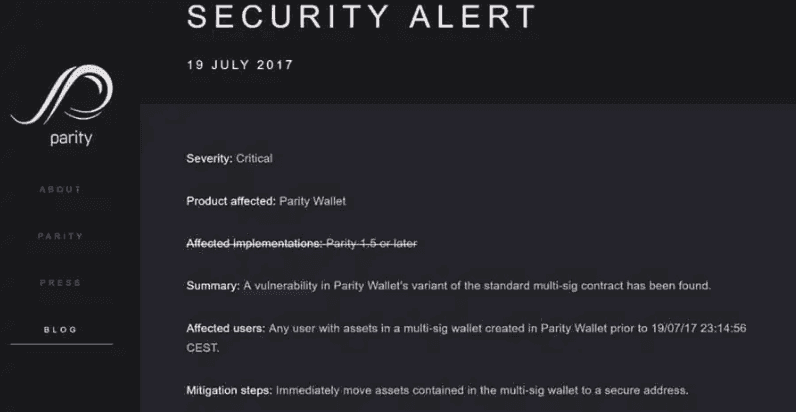
The post-ICO debacle marked the second time the workforce’s wallets had been hacked due to a code vulnerability. The first hack happened earlier in July of 2017 and noticed over 33 million USD of Ethereum drained earlier than the assault was stopped by a benevolent group of hackers generally known as the White Hat Group. In each circumstances, the Polkadot workforce launched follow-up documentation detailing the hacks and tips on how to forestall them from taking place once more.
In January 2019, one other personal funding spherical was held by Polkadot in an try and make up for the misplaced (frozen) funds from the DOT ICO. 500 000 DOT had been offered, elevating over 60 million USD.
In July 2020, a 3rd personal funding spherical was held, promoting just below 350,000 DOT tokens. This raised one other 43 million USD, then in 2022, they raised one other $4 million.
Attempting to get correct figures on the overall quantity of funds raised is troublesome. In accordance with information collected by Cruchbase and Cryptorank, Polkadot has undergone 12 funding rounds in whole for a collective $327,130,000, whereas Alpha Development reveals that Polkadot has raised north of $665,400,000
What’s Polkadot?
Polkadot is a blockchain undertaking that seeks to energy the decentralized way forward for the web (Internet 3.0). Polkadot is also known as a Layer 0 blockchain, in distinction to networks like Bitcoin, Ethereum, Solana, and many others., that are Layer 1 blockchains and Arbitrum, Lightning Community, Optimism, and many others., that are Layer 2 blockchains.
For some fast background:
Layer 0 gives shared safety and interoperability. Different notable tasks that fall underneath the Layer 0 class embody Avalanche and Cosmos. Of those talked about, Polkadot is the one layer 0 that gives full shared safety throughout your complete ecosystem.
Layer 1 is the application-focused chain. Examples are mainnets comparable to Bitcoin, Ethereum, Solana, and many others. We cowl this in additional element in our article on Layer 1 Blockchains.
Layer 2 mostly refers to scalability options on Layer 1s with notable examples being Arbitrum and Optimism for Ethereum and the Bitcoin Lightning community. You’ll be able to be taught extra in our article “What is a Layer-2 Blockchain”
The core utility of Polkadot is that it seeks to supply a safe bedrock of steady general-purpose computation. To place it merely, Polkadot gives shared safety and safe interoperability with the power to assist a number of interoperable blockchains that run in parallel. The time period “Layer 0” refers to Polkadot principal chain’s (relay chain) intentional restricted means to supply safety and finality to the Layer 1 chains, which in flip host sensible contract purposes and extra. I as soon as heard somebody describe Polkadot as being like a large shopping center offering area and safety to completely different retailers. Outlets are shut collectively and might simply talk throughout the similar constructing.
A Frequent false impression is that Polkadot will have the ability to instantly join a number of networks like Bitcoin and Ethereum, which is a bit inaccurate. Polkadot achieves interoperability by means of using bridges which may be constructed on Parachains. Polkadot doesn’t join disconnected blockchain networks however somewhat connects Parachains, offering them with the mandatory infrastructure to allow them to concentrate on utility and utility.
Parachain techniques might supply interoperability with different networks as a utility, and that is anticipated to extend over time. An instance of this already in follow is the Moonbeam community, an EVM-compatible Parachain that helps cross-chain interoperability with Ethereum, permitting its builders to construct Dapps and NFTs on Moonbeam. There may be additionally Snowbridge, an Ethereum-Polkadot bridge Parachain that permits interoperability between the 2 networks.

Polkadot’s parachains enable for the creation of sensible contracts and the relay chain helps new blockchains (and tokens), making it attainable for blockchains to trade data. Notably, Polkadot is upgradeable with no need onerous forks and the protocol is ruled by those that maintain DOT, Polkadot’s native cryptocurrency. Polkadot’s improve to Polkadot 2.0 might usher in sensible contract capabilities on the Relay chain.
Polkadot is a undertaking by Web3 Basis, a Swiss non-profit primarily based in Switzerland’s Crypto Valley (Zug). Web3 Basis commissioned UK-based Parity Applied sciences to develop and preserve the preliminary implementation Polkadot community, which is now maintained by Polkadot’s on-chain governance system.
Dr. Gavin Wooden is the co-founder of each Web3 Basis and Parity Applied sciences and stays Chief Architect of Polkadot working alongside tons of of builders. Polkadot is constructed utilizing Substrate, a blockchain-building device developed by Parity Applied sciences.
How Does Polkadot Work?
Polkadot is actually among the many most technologically superior blockchains in existence. On the Coin Bureau, we usually strive our greatest to clarify blockchain and cryptocurrency in layman’s phrases in an simply digestible format, and that is one other try at distilling an advanced blockchain stack for our readers.
The Polkadot whitepaper calls the Polkadot community a scalable heterogeneous multi-chain. Layer 1 blockchain designs like Bitcoin and Ethereum carry out all blockchain functionalities underneath a single layer. The functionalities are largely categorized underneath three classes –
- Information Retrievability: Blockchain networks preserve a distributed ledger that shops a file of all transactions or information entries. Information retrievability refers back to the idea that this ledger must be accessible to all members within the community. In a public blockchain, anybody can be part of the community, obtain a duplicate of your complete blockchain, and confirm transactions. This ensures transparency and belief within the system as a result of members can independently confirm the info's existence and integrity.
- Consensus: Consensus mechanisms are the protocols that allow blockchain members to agree on the validity of transactions and the order during which they’re added to the blockchain. Consensus is essential for stopping double-spending and sustaining the integrity of the blockchain. Frequent consensus mechanisms embody Proof of Work (PoW), Proof of Stake (PoS), and others, which range when it comes to how they obtain settlement amongst members.
- Execution: Execution refers back to the means of validating and executing sensible contracts or transactions on the blockchain. Sensible contracts are self-executing contracts with the phrases of the settlement instantly written into code. When situations laid out in a wise contract are met, the code routinely executes the contract's phrases with out the necessity for intermediaries. The execution of sensible contracts is a key function of many blockchain platforms, comparable to Ethereum.
These three functionalities work collectively to create a safe, decentralized, and tamper-resistant system during which information may be reliably recorded, transactions may be agreed upon, and sensible contracts may be routinely executed. Legacy blockchain networks like Ethereum use a single world blockchain community to deal with all three core duties underneath a monolithic framework, which is the supply of its scalability points because the community nodes may be overworked from dealing with all of the processes themselves.
Polkadot is a heterogeneous multi-chain that abstracts these features in two separate layers, particularly – the Relay chain and the Parachain:
The Parachains are a number of Layer 1 networks that run in parallel within the Polkadot community. Execution of sensible contracts or transactions can also be dealt with by particular person parachains. Every parachain can have its personal algorithm, logic, and execution atmosphere, permitting for flexibility and innovation on the parachain stage. Parachains can implement their very own consensus mechanisms and execution environments, comparable to Ethereum-compatible execution environments to execute sensible contracts. In contrast to the Ethereum Layer 1, Parachains aren’t burdened with consensus, permitting them to attain the specified scalability. All of the Parachains share essential block information with the Polkadot mainnet, known as the Relay chain, for reaching consensus and inheriting its safety and finality.
The Relay chain varieties the bedrock of the Polkadot community. It’s liable for reaching consensus amongst parachains and making certain the safety and validity of your complete community. Polkadot makes use of a novel consensus mechanism known as Nominated Proof-of-Stake (NPoS) to attain this consensus. Validators on the relay chain are liable for producing blocks and securing the community by staking DOT tokens.
Information availability for particular person parachains is primarily the duty of the parachains themselves. Every parachain has its personal set of validators and maintains its personal information and state. The relay chain not directly helps guarantee information availability by coordinating the community and offering safety, however the particular information availability for every parachain is managed inside that parachain's community.
Polkadot Structure

The Polkadot Community contains of the next three roles:
Validators
Validators check with the total nodes of the Polkadot relay chain that take part in its consensus course of to safe the Polkadot community, together with parachains. Be aware that the parachains are solely involved with the execution and depend on the relay chain for consensus and finality, which they obtain with the assistance of validators.
Every parachain is appointed a validator subgroup. These subgroups settle for parachain blocks and conduct the mandatory validity checks to make sure the blocks had been constructed per the foundations of consensus of the parachain. As soon as all new parachain blocks have been correctly verified, the validators embody them within the relay chain block. Now the validators must validate the relay chain block itself; they accomplish that by processing all of the transactions of the relay chain and together with the ultimate parachain adjustments within the block.
The quantity of DOT required to be thought-about as a Validator is determined by community participation and might change over time. It relies upon not solely on how a lot stake is being put behind every validator, but additionally on the dimensions of the energetic set and what number of validators are ready within the pool. Moreover, the checklist of validators adjustments each period, which is each 24 hours.
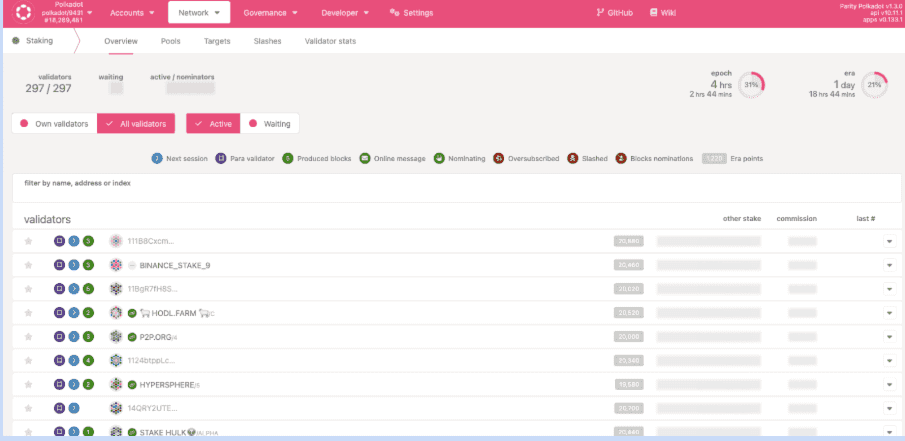
Polkadot began with 20 open validator positions and has opened extra progressively. The last word sure on the variety of validators has not been decided but and may solely be restricted by the bandwidth pressure of the community as a result of peer-to-peer message passing, however the finish aim for Polkadot is to have 1000 validators authenticating transactions on its community.
When a brand new block containing Parachain transactions is generated by validators on the Relay chain, 20% of block rewards are distributed amongst validators in accordance with the quantity of “era points” they’ve amassed. The validators are liable for a handful of extra infrastructural duties for community repairs. The extra duties they carry out, the extra period factors they earn.
Nominators
A nominator is a community participant who delegates its DOT to the validator to take part within the Polkadot consensus. They haven’t any further position besides to position threat capital to suggest that they belief a selected validator to behave actually to propagate the Polkadot community.
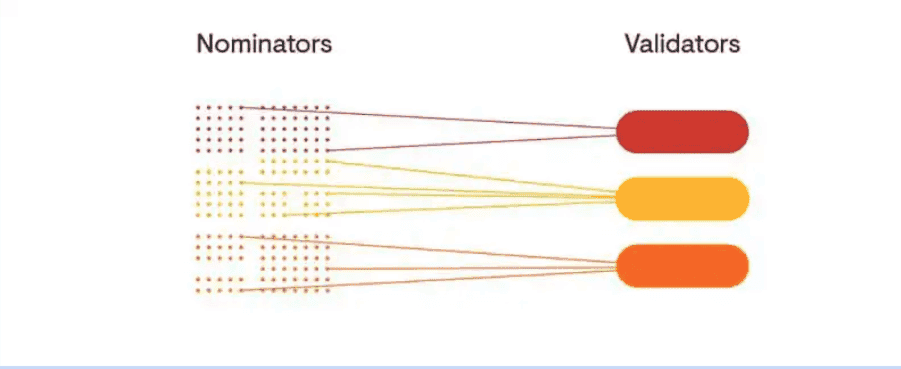
Collators
Collators help the validators in consensus by developing the parachain blocks. Collators preserve a full node for a selected Parachain and a full node of the Relay chain. As a Parachain full node, they preserve all essential data, like transaction information, signatures, and state transitions, to assemble parachain blocks. They collate and execute parachain transactions to create parachain blocks. They supply these blocks, together with a zero-knowledge proof of the validity of Parachain transactions to a number of validators liable for proposing the Parachain block.
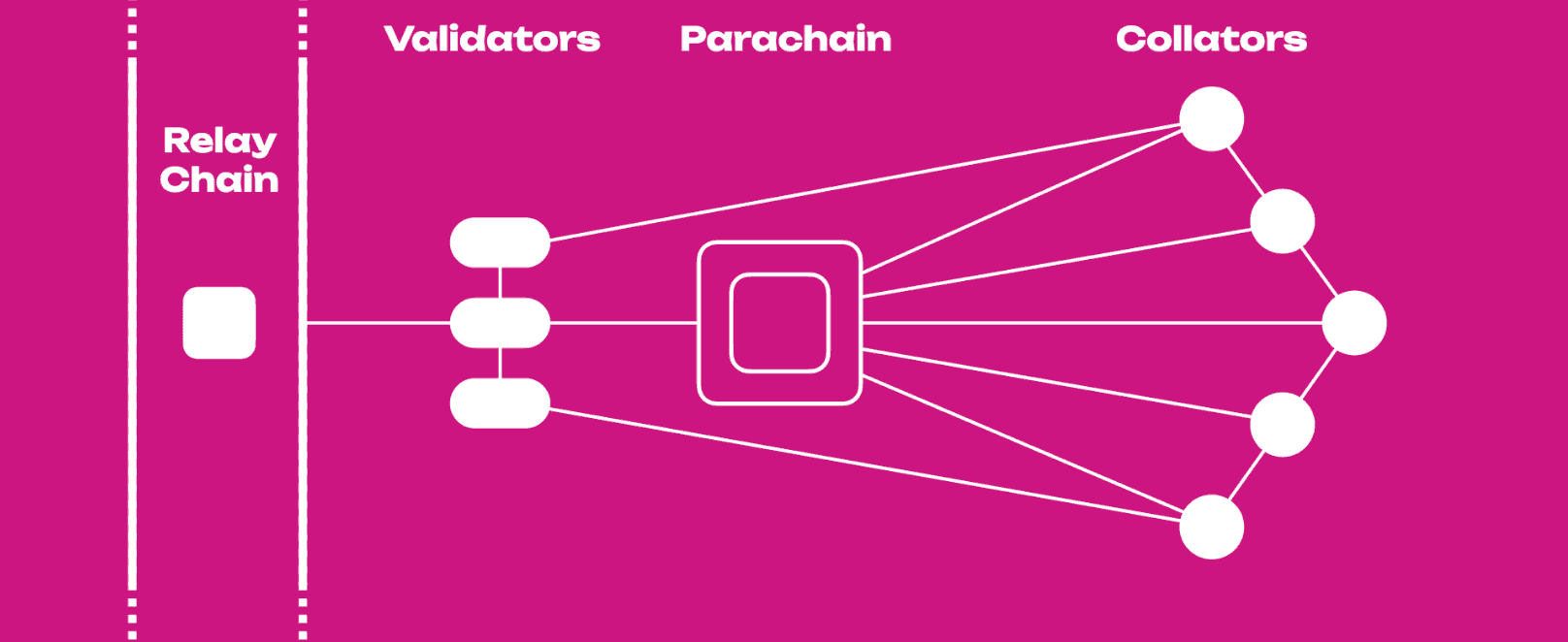
Polkadot Consensus
The Polkadot relay chain adopts a novel Nominated Proof of Stake (NPoS) consensus course of to safe its blocks, designed to optimize community safety and effectivity. Right here’s the way it works:
- Roles: NPoS includes two principal roles:
- Validators: Liable for validating transactions and sustaining the blockchain.
- Nominators: Stake their tokens by backing reliable validators, serving to to safe the community.
- Nominating Validators: Token holders can nominate validators they belief. This course of includes staking DOT, Polkadot's native token.
- Election of Validators: An election mechanism selects validators from the pool of nominees. This course of considers the quantity of stake backing every validator to make sure a balanced and safe community.
- Staking Rewards and Dangers: Each validators and nominators obtain staking rewards proportional to their staked quantity. Nevertheless, additionally they share dangers; any malicious actions by a validator can result in slashing, the place a portion of the staked DOT is misplaced.
- Safety and Effectivity: NPoS is designed to maximise the quantity of stake securing the community, enhancing its safety. Validators are incentivized to carry out effectively and actually because of the financial stakes concerned.
In abstract, Polkadot's NPoS is a complicated consensus mannequin that aligns the incentives of assorted community members to take care of a safe, environment friendly, and decentralized ecosystem.
Polkadot XCM (Cross-chain Messaging)
Within the Polkadot ecosystem, XCM stands for Cross-Consensus Messaging. It's a protocol designed for communication between completely different blockchains (parachains) inside and exterior the Polkadot and Kusama networks. XCM allows these various blockchains to ship messages to one another, regardless of probably having completely different consensus mechanisms or state transition features. Right here's an in depth have a look at how XCM facilitates cross-chain communication:
- Protocol Design: XCM is a language and format for messages. It's designed to be as basic and summary as attainable to accommodate a variety of potential use circumstances and blockchain designs.
- Message Sending and Receiving: A parachain can ship an XCM message to a different parachain with out these messages needing to be saved on the Relay chain.
- Cross-Consensus Compatibility: XCM is designed to be appropriate throughout completely different consensus techniques. Because of this a blockchain utilizing one consensus mechanism can talk with one other blockchain utilizing a special mechanism.
- Use Instances: The makes use of of XCM are diverse and might embody transferring tokens between parachains, making calls to sensible contracts positioned on one other parachain, or some other type of data or command that may should be communicated in a multi-chain atmosphere.
- Decentralization and Safety: XCM leverages the shared safety mannequin of Polkadot. This ensures that cross-chain communication is as safe as the interior operations of a single parachain.
In abstract, XCM in Polkadot is a strong device for enabling interoperable performance between completely different blockchains in a safe, environment friendly, and decentralized method, which is a cornerstone of the Polkadot philosophy. XCMP is the transport layer for delivering XCM messages. It provides the transportation methodology and a safe route however not a framework for binding agreements.
Lifetime of a cross-chain message in XCM
The lifetime of XCM format facilitated cross-chain message in Polkadot includes a number of steps. Right here’s a breakdown:
- Message Creation: A consumer or utility on a Parachain initiates a cross-chain operation, creating an XCM message. This message is formatted to be universally understood throughout completely different parachains with various consensus mechanisms and state transition features.
- Submission to Native Parachain: The XCM message is first submitted to the native Parachain. Right here, it's processed in line with the parachain's guidelines and ready for transmission to a different parachain.
- Relay Chain Involvement: The native Parachain forwards the XCM message to the Polkadot Relay chain. The Relay chain performs a central position in Polkadot's structure, interconnecting all parachains and facilitating their communication.
- Routing the Message: The Relay chain then routes the message to the vacation spot Parachain. This routing is predicated on the knowledge contained within the XCM message, which specifies the goal Parachain and the supposed operation.
- Receipt by Vacation spot Parachain: The vacation spot Parachain receives the XCM message from the Relay chain. It interprets the message in line with its personal logic and executes the requested operation.
- Execution and Response: The vacation spot Parachain executes the operation requested within the XCM message. This might contain token transfers, sensible contract executions, or different blockchain operations.
- Suggestions Loop (if relevant): Relying on the character of the cross-chain operation, a response or affirmation could also be generated by the vacation spot Parachain and despatched again to the unique Parachain utilizing the identical XCM protocol.
- Finalization: The operation is accomplished, and any adjustments are finalized on each the origin and vacation spot Parachains.
All through this course of, the safety and consensus mechanisms of Polkadot make sure that the cross-chain communication is safe and dependable. The XCM protocol's design as a generic and summary messaging format permits for all kinds of cross-chain interactions throughout the Polkadot ecosystem.
How Are Parachains Chosen?
The Ethereum community is totally permissionless, which means anybody can conduct any operation on the community, so long as it adheres with the consensus means of the Ethereum protocol. Subsequently, builders have full autonomy over deploying any sensible contract they need on the Ethereum mainnet, together with sensible contract rollups.
The Polkadot community works barely in another way. The undertaking’s preliminary imaginative and prescient solely needed to let good high quality and effectively developed Parachains to hook up with the Relay chain and profit from its safety. So, Polkadot launched slot auctions to manage the variety of Parachains on Polkadot at any time. Right here’s how the public sale labored previous to the Polkadot 2.0 improve.
- Objective: Slot auctions are used to find out which Parachains will probably be linked to the Polkadot Relay chain. Being linked to the Relay chain permits a Parachain to learn from the shared safety and interoperability options of Polkadot.
- Parachain Slots: These are the accessible positions on the Relay chain for Parachains to hook up with. Every slot has a restricted period, sometimes starting from a number of months to a few years.
- Public sale Course of:
- Candle Public sale Format: Polkadot makes use of a model of the candle public sale, a mechanism traditionally used for promoting ships. The top of the public sale is decided retroactively after the public sale has ended, making it onerous to sport the system by making last-minute bids.
- Bidding: Tasks bid for slots by locking up DOT tokens. The quantity of DOT locked and the period of the lease are components within the bidding course of.
- Random Ending: The precise ending time of the public sale shouldn’t be identified to members, which discourages last-minute bidding methods.
- Profitable the Public sale:
- Willpower of Winners: The winner is the undertaking that has the very best bid on the randomly chosen ending level of the public sale.
- Leasing the Slot: Profitable tasks get to lease the Parachain slot for the period they bid for. Throughout this time, their Parachain is linked to the Relay chain.
- Locked DOT: The DOT tokens bid within the public sale are locked all through the slot lease. They don’t seem to be spent however are somewhat a bond securing the Parachain's place on the Relay chain.
- Crowdloans:
- To assemble sufficient DOT for a bid, tasks usually use crowdloans, the place they crowdsource DOT from their group.
- Contributors to crowdloans might obtain rewards from the undertaking, comparable to tokens or a share within the undertaking’s success.
- Finish of Lease: As soon as the lease interval ends, the Parachain slot is up for public sale once more, and the locked DOT is returned to the undertaking or its crowdloan contributors.
Slot auctions are a basic a part of Polkadot's governance and financial mannequin, making certain a good and clear course of for allocating restricted sources (parachain slots) within the community.
Coretime in Polkadot
The validators of the Polkadot community are dynamically assigned to validate completely different parachain blocks. Polkadot affords sturdy ensures that the Parachain state transitions are legitimate by means of a set of validators cryptographically randomly segmented right into a subset for every Parachain; with these subsets differing for each block.
Coretime refers back to the availability and allocation of those validator subsets as computational sources (cores) for processing parachain blocks. The Polkadot community at present helps 50 such cores. Every core can host a Parachain that utilises all of the sources or a number of parathreads that use a number of the accessible sources. The cores run in parallel, processing a number of complicated duties concurrently. Polkadot can also be known as the “Polkadot Supercomputer,” representing the collective means to course of a lot of duties.
Polkadot OpenGov – A Democratic Governance Construction
The Polkadot community not too long ago overhauled its governance mechanism. It gave up Governance V1 to undertake OpenGov, a extra democratic and equitable format of protocol governance that slashes privileges and allows a better voice for the DOT group. We suggest studying about Governance V1 to understand the adjustments launched in OpenGov.
Parting with Governance V1
The primary governance system of Polkadot included three principal elements: the Technical Committee, the Council, and the Public (all token holders). The Technical Committee was liable for managing improve timelines, whereas the Council, an elected physique, dealt with parameters, administration, and spending proposals. Whereas the Public (token holders) performed an important position within the governance course of, the Council would scrutinize their proposals earlier than they may enter the voting section.
Regardless of its effectiveness in managing treasury funds and facilitating upgrades, Governance V1 had limitations. It allowed just one referendum to be voted on at a time (apart from emergency proposals), with voting durations lasting a number of weeks. This method favoured rigorously contemplating a couple of proposals over a broader vary of concepts, probably limiting the community's means to adapt and evolve rapidly. V1 additionally restricted the general public’s voice by implementing the council and having to safe endorsements. The necessity for better decentralization and democracy led to the adoption of OpenGov.
Polkadot OpenGov
Polkadot OpenGov launched vital adjustments to deal with the shortcomings of Governance V1. The brand new system goals to decentralize decision-making additional and enhance the variety of collective choices attainable at any given time. Key adjustments embody:
- Dissolution of the Council and Technical Committee: The Council collective was dissolved, and the broader Polkadot Technical Fellowship changed the Technical Committee.
- Direct Democracy Voting System: The duties of the Council had been migrated to the general public, who can now instantly provoke new proposals.
- Enhanced Delegation Choices: Customers can now delegate voting energy to group members in additional various methods, permitting for a extra nuanced illustration of stakeholder pursuits.
- A number of Origins and Tracks: Proposals are actually initiated by the general public and enter completely different tracks primarily based on their nature, with every observe having a devoted origin. This method permits for simultaneous voting on a number of referenda, enhancing the governance course of's flexibility and responsiveness.
Be aware: A deep dive on how OpenGov works can also be accessible for individuals who need to be taught extra.
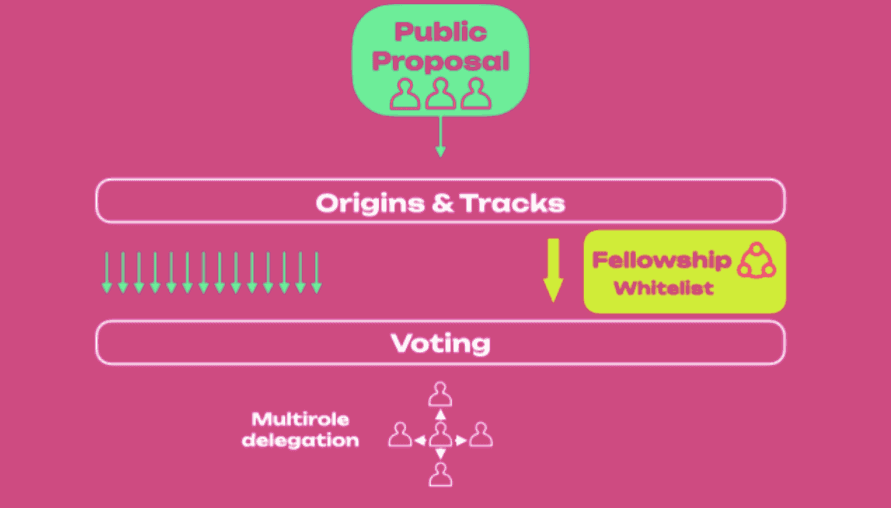
In OpenGov, DOT holders provoke all proposals. In contrast to Governance V1, OpenGov permits the group to work on a number of proposals in parallel. OpenGov organizes the proposals on the premise of what it goals to implement, categorized underneath fifteen completely different Origins. Every origin follows a specifically crafted ‘track’ comprising preset configurations to control the voting course of. The Origins & Tracks system ensures each proposal receives satisfactory publicity to the group’s time and sources.
Some governance proposals are time-sensitive, requiring decisive decision-making, whereas others are extra foundational and resource-intensive, demanding better introspection and testing. OpenGov is a platform the place all such various sorts of proposals don’t compete with each other for the group’s consideration and might develop collectively holistically.
Key Advantages of OpenGov:
- Decentralization: OpenGov shifts the governance energy from a centralized council to a extra direct democracy mannequin. By dissolving the Council and the Technical Committee, and transferring their duties to the general public, OpenGov fosters a extra decentralized strategy to decision-making.
- Inclusivity and Group Empowerment: OpenGov introduces extra nuanced delegation choices. This function encourages broader participation in governance, as stakeholders can contribute to decision-making in areas they’re most educated about or enthusiastic about.
- Adaptability and Evolution: The introduction of a number of origins and tracks for proposals underneath OpenGov permits for a extra versatile and responsive governance system. This method can adapt to various kinds of proposals, making certain that the governance course of is environment friendly and efficient.
- Transparency and Accountability: The introduction of the Technical Fellowship and the power to whitelist proposals for expedited processing improve the community's means to reply swiftly to crucial updates or enhancements.
- Scalability and Effectivity: OpenGov's design permits for a number of referenda to be voted on concurrently, growing the governance system's effectivity. This scalability is essential for the dynamic coretime administration system in Polkadot 2.0.
Polkadot 2.0 proposed a course for the community that lets go of its periodic gradual auctions mannequin to undertake a dynamic, ‘pay as you go’ mannequin for plugging Parachains to the Polkadot community. The brand new imaginative and prescient cited some limitations of the slot auctions like the next:
- Rigidity in Useful resource Allocation: The unique slot public sale mannequin allotted parachain slots for mounted durations, missing the pliability to adapt to various undertaking wants or adjustments in community situations.
- Excessive Entry Barrier for New Tasks: The requirement to lock up is critical.
Polkadot 2.0
In Polkadot Decoded 2023 held in June, Parity Applied sciences founder Gavin Wooden shared a brand new imaginative and prescient for the Polkadot community. The quantity of DOT wanted for prolonged durations might be prohibitive for smaller or newer tasks, limiting their means to take part within the Polkadot ecosystem.
- Inefficient Useful resource Utilization: Mounted slot leases may not all the time align with precise useful resource utilization, resulting in conditions the place allotted sources are underutilized.
- Financial Constraints: The necessity to bond a lot of DOT tokens for slot auctions may result in lowered liquidity out there and probably larger alternative prices for tasks.
- Challenges in Lengthy-Time period Planning: Tasks may face uncertainty in long-term planning, given the competitors and uncertainty related to successful subsequent slot auctions to take care of their parachain standing.
The renewed Polkadot imaginative and prescient doesn’t introduce any new paradigm to the ecosystem. Somewhat, it underpins the groundwork laid down by the community on the most basic stage. At its most elementary, the Polkadot community:
- Is a platform that gives a safe blockspace, somewhat than safe blockchains.
- Is a platform to construct purposes. Though Polkadot facilitates constructing chains, enabling utility by means of purposes for customers is its core goal.
- Supplies steady coretime, i.e. a vessel for general-purpose computation.
- Is a supercomputer, with a number of cores that function perpetually in parallel.
The above generalization represents a paradigm shift from Polkadot behaving as an ecosystem that providers chains to an application-focused ecosystem. With the slot auctions, Polkadot 1.0 allocates a core to every Parachain for a hard and fast interval. Within the new system, all of the cores can be found as sources consumable by all of the Parachains, with none specific allocation like earlier than. Subsequently, there will probably be no want for slot auctions anymore.
Core Utilization in Polkadot 1.0 vs 2.0
In Polkadot 1.0, every core allotted to a parachain produced a block each 12 seconds, no matter community necessities and demand, resulting in inefficient use of coretime. The determine beneath illustrates core utilization. Every color represents a Parachain propagating in blocks in separate cores in time.
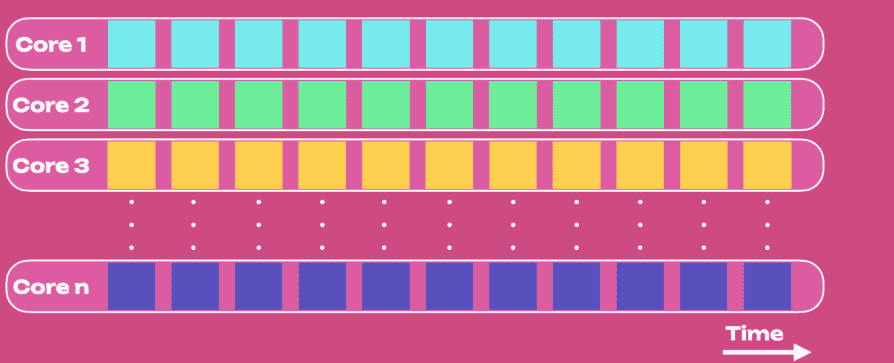
To realize full effectivity, the cores should be optimized for optimum utilization no matter Parachain. In Polkadot 2.0, the cores are utilized as a homogeneous useful resource, permitting for a single core, or perhaps a single coretime to supply computation to a number of Parachians collectively. A coretime generalization at this scale results in environment friendly useful resource utilization. We will illustrate this shift in a number of configurations:
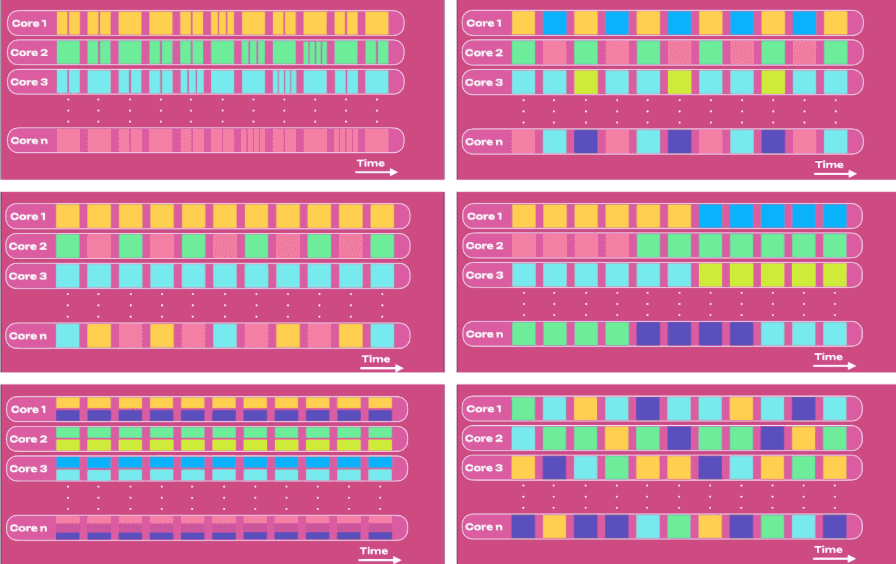
Lastly, an agile coretime allocation and core utilization illustrated within the configurations above will probably be composable, enabling an environment friendly decentralized computing system that’s world inside Polkadot, versus localized inside cores.

Coretime Market
How does Polkadot allow this core agility? Fairly surprisingly, it already existed however was by no means used. The cores as outlined above primarily carry out their computations on a contemporary CPU, which may simply and swiftly change what job they carry out and what computations they execute. Subsequently, the cores have all the time been agile and will carry out basic computations.
Nevertheless, the slot auctions in Polkadot 1.0 prevented the community from leveraging this agility by limiting the cores to a single Parachain. The brand new imaginative and prescient replaces slot auctions with the coretime market, the place coretime is commoditized. The coretime market in Polkadot 2.0 will tokenize coretime, enabling its commerce such that any Parachain in want of extra coretime and purchase it from Polkadot or different Parachains with extra accessible coretime.
Parachains will have the ability to purchase need-based coretimes:
- Bulk coretime – A typical coretime rental by means of a dealer parachin at a hard and fast value for a hard and fast time interval.
- Instantaneous coretime – Out there by means of sale of coretime for fast use at spot value. The group has usually referred to this as “pay as you go.”
This method will enable for outdated Parachains to purchase coretime upfront and new Parachains with restricted sources to purchase coretime as wanted.
XCM and Accords
The Polkadot documentation argues that whereas the XCM cross-cain messaging format ensures trustworthy supply of cross-chain messages between chains, there may be nonetheless an opportunity that the chains might interpret these messages incorrectly. In any case, Parachains are provided design flexibility by the relay chain, so an opportunity of misinterpretation does exist.
Polkadot 2.0 describes Accrods, which acts as a type of treaty between any two Parachains. Whereas XCM ensures environment friendly supply of cross-chain messages through XCMP channels, Accords will assure trustworthy and proper execution of these messages on the vacation spot chain.
Asynchronous Backing
Asynchronous backing is an effort to additional enhance the effectivity of the Polkadot community by loosening the foundations that outline how Parachains decide to the relay chain, with out sacrificing the safety and resiliency of the community.
Synchronous backing in Polkadot 1.0
Let’s break this time period down to know it a bit higher. Firstly, backing refers back to the anchoring means of collators. The Parachain collators submit Parachain block headers to the relay chain to inherit its safety. The synchronous backing in Polkadot 1.0 meant that the collators had been solely allowed to anchor to the most recent Relay chain block. As Parachains and the Relay chain run in parallel, each present Parachain block may solely anchor to the present Relay chain block inside a short while window accessible for them, a limitation that the Polkadot devs argue results in congestion and slowed throughput.
Asynchronous backing in Polkadot 2.0
The Polkadot 2.0 improve proposes to interrupt this synchrony. The Parachain and the Relay chain nonetheless run in parallel, producing new closing (linked) blocks collectively. Nevertheless, with the optimization of Polkadot’s consensus protocol, the collators will probably be allowed to anchor present Parachain blocks to historic relay chain blocks. Asynchronous backing improves effectivity in two broad methods:
- With Parachains now not restricted by the throughput of the Relay chain, they’ll pipeline blocks, or produce a number of unlinked blocks which will anchor to a later Relay chain block, growing effectivity and scalability.
- Ancestor Relay chain blocks with no hyperlinks to a selected Parachain are nonetheless good for proposing new Parachain candidates, bettering community useful resource utilization.
Polkadot devs declare that asynchronous backing can present as much as 4x extra time for Parachain to execute its operations and produce blocks, in addition to 2x the throughput of these blocks. The proposed improve results in a number of advantages like environment friendly useful resource utilization and lowered latency for the Polkadot ecosystem that may understand over the quick to long run.
The preliminary testing of asynchronous backing will first occur on Versi and Rococo testnets. If profitable, Polkadot’s on-chain governance will first deploy it on the Kusama community and eventually on Polkadot if every part works as supposed.
Polkadot 2.0 Abstract
The Polkadot 2.0 improve marks a major evolution within the community's structure, akin to the shift from a conventional workplace setting to a contemporary co-working area. On this analogy, Polkadot 1.0 resembles a conventional workplace the place sources, like workplace area (parachain slots), are leased out on long-term, mounted contracts. This setup, whereas secure, affords restricted flexibility and may be much less environment friendly for dynamic or rising organizations.
The introduction of Polkadot 2.0 transforms this mannequin right into a co-working area, the place sources (blockchain computational capability or "cores") can be found on a extra versatile, demand-driven foundation. On this new atmosphere, akin to a co-working area, entities can use sources as wanted, adapting rapidly to altering necessities and alternatives. This shift not solely maximizes useful resource utilization but additionally lowers entry boundaries, fostering a extra vibrant and inclusive ecosystem. Simply as a co-working area encourages collaboration and innovation amongst its various occupants, Polkadot 2.0 paves the best way for a extra dynamic, environment friendly, and collaborative blockchain community.

The illustration above clearly depicts this transition. Polkadot 1.0 (left) represents a inflexible workplace constructing with one Parachain per core (workplace flooring). Polkadot 2.0 (proper) represents dynamic utilization of cores. Completely different co-working settings characterize every core operating a number of Parachains concurrently.
Polkadot’s DOT Cryptocurrency
DOT is the native cryptocurrency on the Polkadot community. It’s used for governance, staking, and bonding on the Polkadot community. Anybody who holds DOT can vote for proposed adjustments to Polkadot.
As famous within the part on how Polkadot works, DOT is used for staking by Validators and Nominators on the community. DOT can also be used for bonding Parachains to the Relay chain through Collators.
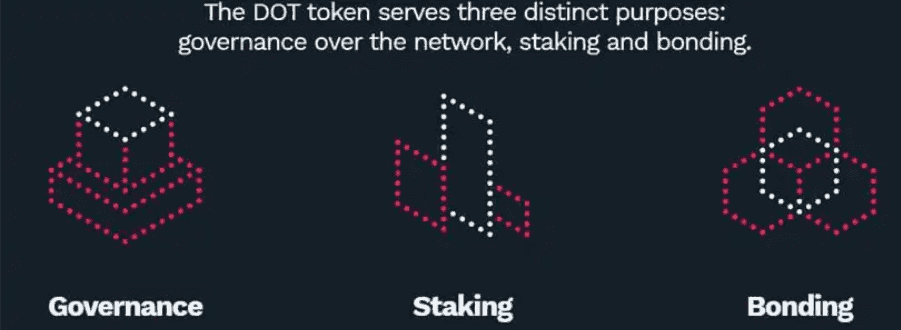
Though DOT initially had a max provide of 10 million, this was modified to permit for a level of inflation to incentivize community participation.
The goal participation price for occasions comparable to staking and Parachain auctions for Polkadot is 75%, which corresponds to an inflation price of 10% per yr. The inflation price may be as excessive as 100% per yr if there may be not sufficient community participation. The present whole provide of DOT is over 1.2 billion.
As for Tokenomics, DOT distribution is as follows:
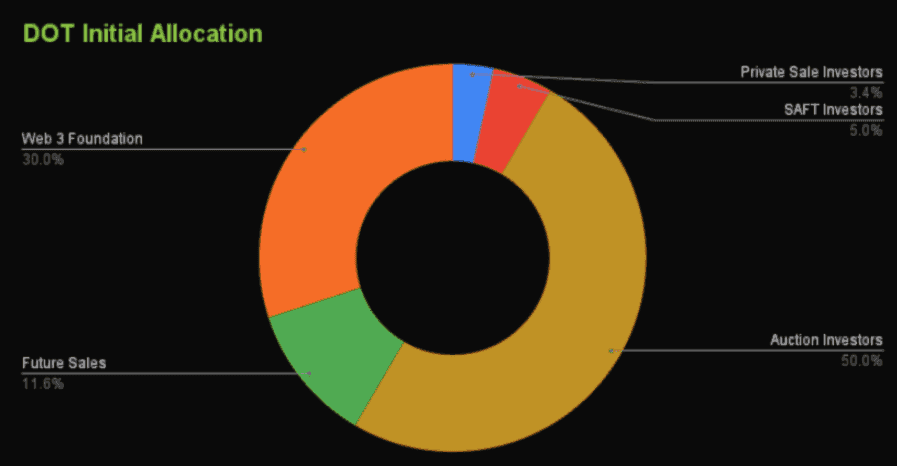
- 3.42% is allotted to Personal Sale Traders
- 5.00% is allotted to SAFT Traders
- 50.00% is allotted to Public sale Traders
- 11.58% is allotted to Future Gross sales
- 30.00% is allotted to Internet 3 Basis
And here’s a have a look at the Polkadot provide schedule, displaying no main token unlocks that customers should be cautious of:
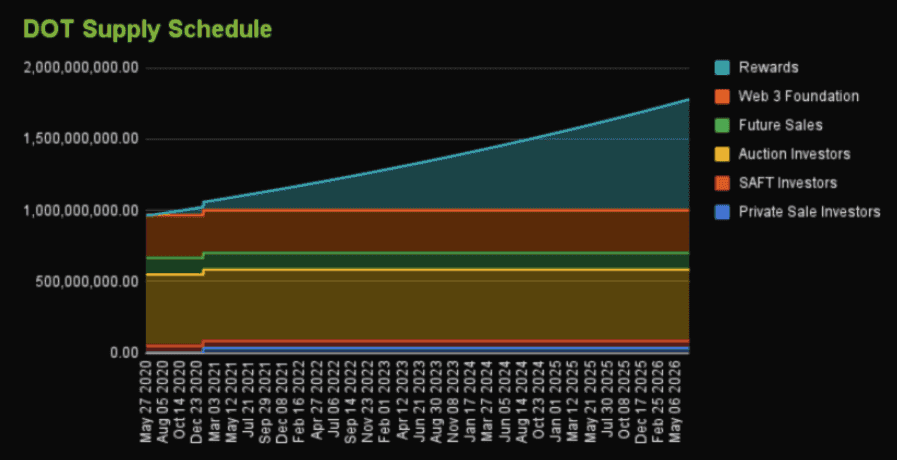
DOT Value Evaluation
Polkadot is at present a prime 20 cryptocurrency undertaking by market capitalization, falling outdoors of the highest 10 in 2022. Shortly after DOT was launched to the general public, it noticed an explosive enhance to $47.33 throughout April-Could 2021 bull run.

Close to the top of 2021, Polkadot surpassed its earlier all-time excessive to achieve a brand new peak, topping out at $54.98 in November 2021, an astonishing 1,936% value enhance!
However in fact, the 2022-2023 crypto winter hit Polkadot onerous, similar to the remainder of the crypto area, leaving DOT value down over 90% from its all-time excessive to a value of round $3. Polkadot is forex sitting at $7.62 as we’re getting into what many hope to be the early levels of the subsequent bull run.
If we check out the 90-day value motion, we will see that as curiosity is returning to the crypto area, DOT put in consecutive larger highs and better lows, displaying that there’s investor curiosity. With the latest developments popping out of the Polkadot undertaking, the undertaking’s huge potential, and the thrill witnessed through the 2021 bull run, many Polkadot buyers really feel that DOT is displaying indicators of being one other one to regulate for the subsequent bull market.
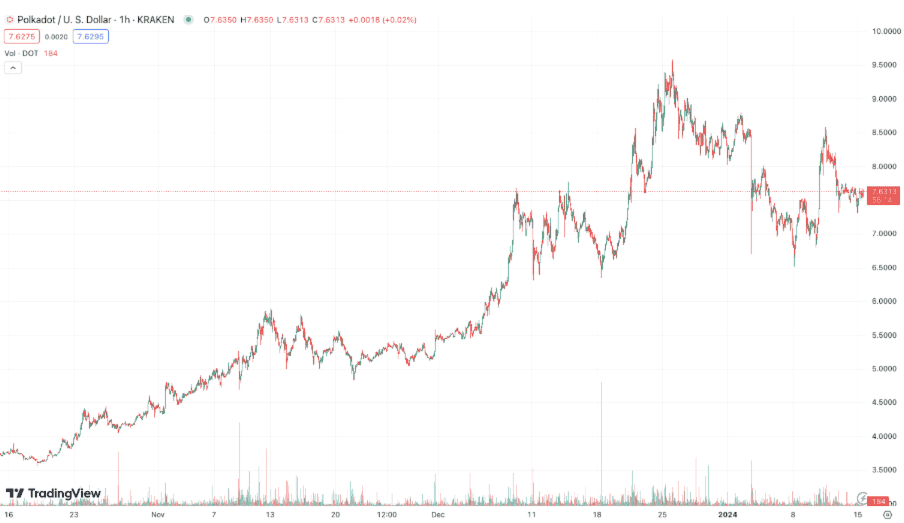
Past value, Token Terminal reveals extra bullish metrics over the previous 90 days. Polkadot's market cap has elevated 104.8% whereas DOT buying and selling quantity is up a powerful 213%
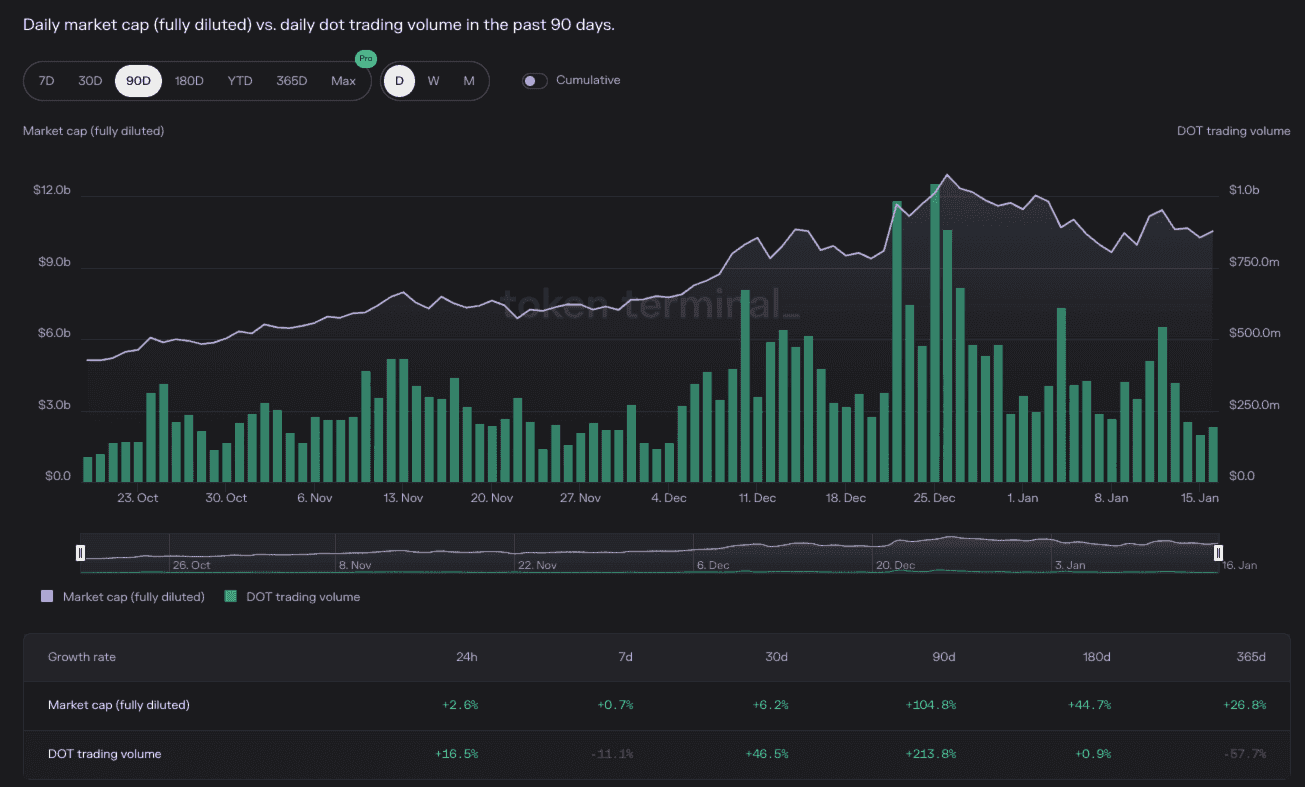
Zooming out to the previous 12 months, we will see pretty secure core developer numbers regardless of the brutal yr we’ve had price-wise, which is usually a very good signal of a wholesome ecosystem.
The place to Purchase Polkadot (DOT)
These trying to purchase Polkadot have loads of choices. As this can be a large-cap undertaking with huge potential, DOT is accessible on most respected exchanges. We suggest Bybit, Binance or OKX for these trying to commerce DOT and SwissBorg or Kraken for these searching for safe and simple locations to purchase DOT.
For individuals who desire to take the DEX route, HydraDX is a number one DEX on Polkadot the place customers can DCA into DOT, present liquidity, and commerce in a decentralized method. Yow will discover out extra about all of the tasks constructing within the Polkadot ecosystem by going to dotmarketcap.com.
Greatest Polkadot Wallets
Within the early days, the selection of Polkadot wallets had been slim as most mainstream wallets didn’t supply DOT assist. Now, for folk searching for the very best Polkadot pockets, there are some stable decisions, each {hardware} and software program wallets can be found.
For customers desirous to get entangled within the DOT ecosystem, Nova Pockets is an effective alternative for cellular wallets and Talisman is a well-liked browser extension pockets.
For {hardware} wallets, one in all our favourites for long-term holding and staking DOT is the ELLIPAL Titan pockets. Ledger additionally helps Polkadot however doesn’t assist Parachains presently.
For superior customers and builders, customers can take into account the Polkadot Vault, the Polkadot-JS UI Internet Pockets and Subkey.
How Polkadot 2.0 Aligns With the Evolving Web3 Panorama
The Polkadot 2.0 improve represents a shift within the ethos of the Polkadot ecosystem right into a platform made for customers from a platform made for chains. This shift resonates with the rising significance of Web3 getting into 2024 and aligns with the overreaching technological developments evolving on this panorama:
- Interoperability: Polkadot 2.0's concentrate on enhanced interoperability aligns properly with the Web3 imaginative and prescient of a decentralized and interconnected web. As extra blockchain tasks and decentralized purposes emerge, the power to speak and share sources throughout completely different networks will probably be more and more important.
- Scalability: Though the Polkadot community was already extremely scalable with ample sources to deal with giant quantities of site visitors, upgrades in Polkadot 2.0 intention to enhance scalability much more, making certain the community is ready for the mass adoption of Web3 applied sciences. By permitting for environment friendly and dynamic allocation of sources (by means of mechanisms like elastic cores and dynamic coretime), Polkadot can higher accommodate rising numbers of transactions and customers.
- Person Expertise: Enhancements in transaction velocity, value, and total community effectivity can considerably improve consumer expertise, a key facet of broader Web3 adoption. Polkadot's upgrades are anticipated to contribute to a smoother and extra accessible expertise for customers and builders alike.
- Decentralization and Safety: Polkadot's shared safety mannequin and decentralized governance construction embody core Web3 rules. Upgrades that improve these facets will additional align Polkadot with the ethos of a decentralized, user-empowered web.
- Innovation and Flexibility: Because the Web3 panorama evolves, so do the wants and aspirations of its members. Polkadot 2.0's extra versatile framework is more likely to encourage innovation, permitting builders to adapt and create options that meet rising wants and alternatives.
Polkadot was already believed to be a high-quality undertaking with huge potential previous to the rollout of two.0. To cite our mates over at Altcoin Each day about their tackle Polkadot 2.0:
“The Polkadot of the past was quality. The Polkadot of the future is exceptional” (Supply)
Whereas the specifics may evolve, the core rules and options being launched with Polkadot 2.0 are more likely to be well-aligned with the wants and developments of the Web3 panorama in 2024 and past.
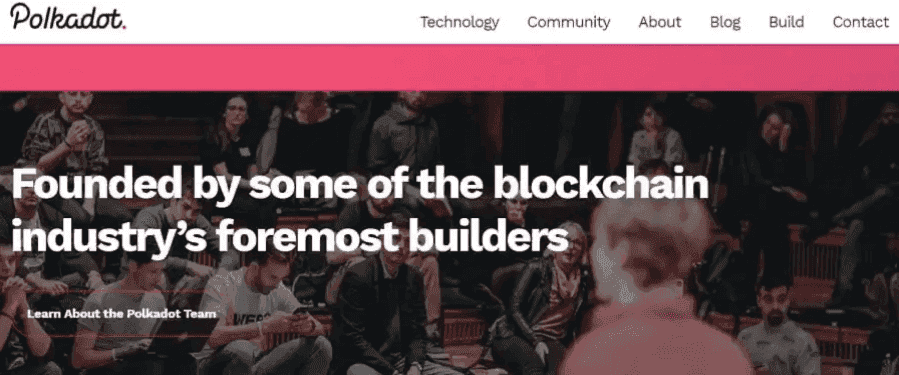
Now, we might be remiss if we didn’t take a second to check Polkadot to Ethereum.
On a excessive stage, Ethereum and Polkadot undertake two very completely different blockchain designs that serve completely different objectives:
- Ethereum is a monolithic, general-purpose blockchain. The only goal of Ethereum is to execute the sensible contracts within the Ethereum Digital Machine and hold all of the nodes in sync with the outcomes of these executions.
- Polkadot is a heterogeneous blockchain, consider Polkadot as a blockchain with two layers, and every layer with its personal sole goal. The Parachains execute state transitions just like the Ethereum Digital Machine, and the relay chain retains the nodes in sync with consensus.
Ethereum vs Polkadot: Sharding
The Polkadot ecosystem is a purely sharded community. It’s characterised as ‘pure’ as a result of every Parachain is, actually, a separate however parallelly working blockchain. So, Polkadot is a sharded community the place the shards (Parachains) are literally break up networks that make their block information accessible to the Relay chain to inherit its safety. Subsequently, scalability from sharding on Polkadot is achieved by truly operating separate networks in parallel.
The rollup-centric roadmap of Ethereum thinks of sharding from a special perspective. Ethereum will quickly implement Danksharding. Danksharding is completely different from Polkadot’s sharding logic within the following methods:
- Danksharding will enhance the scalability of Ethereum by bettering the throughput of rollups.
- Danksharding won’t truly break up the Ethereum community like Parachains are in Polkadot, as an alternative, the Danksharding improve will considerably enhance the quantity of transaction information rollups can commit at every Ethereum block such that they obtain scalability of an precise sharded community.
To summarize, one might name Polkadot an actual sharded community, whereas Ethereum is an successfully sharded community. Be at liberty to refer to the Polkadot docs to dive deeper into the architectural variations between Polkadot and Ethereum.

There are only some points we see with Polkadot. The primary includes the educational curve, which is already very steep for cryptocurrency generally, a lot much less the assorted purposes and protocols inside DeFi. Then, as with different tasks, we must be cognizant of the lengthy checklist of questions on every part that might go flawed with a community-governed hybrid consensus community.
As with many blockchain applied sciences, there may be regulatory uncertainty surrounding facets of Polkadot's operation, notably regarding cross-border transactions, safety legal guidelines, and the standing of its native token (DOT). Navigating this evolving regulatory panorama is a problem for many blockchains and their customers.
Luckily, Parity Applied sciences has been in energetic engagements with the SEC to categorise Polkadot as a software program and DOT was by no means explicitly named as a safety when the SEC determined to make wide-sweeping claims towards 68 cryptocurrencies they really feel are securities.

Whereas it’s nonetheless too early to say how the regulatory panorama will affect the crypto trade in the long term, this can be a optimistic early signal and a landmark second showcasing that Polkadot, as a expertise, might be well-positioned to outlive the onslaught of the upcoming regulation storm that’s brewing.
The ultimate situation Polkadot faces includes interoperability. Whereas the undertaking is marketed as being extraordinarily interoperable, in actuality, that is solely true relating to different blockchains constructed utilizing Substrate. Any “external” blockchains comparable to Bitcoin or Ethereum would require a bridge to hook up with Polkadot through its Parachains. Fortunately, bridge protocols for Polkadot comparable to Hyperbridge and Snowbridge are paving the best way for cross-chain interoperability together with Picasso as a bridge to the Cosmos ecosystem, and there are quite a few mid-cap and even large-cap cryptocurrencies being constructed on Substrate.
It's vital to notice that the Polkadot group is actively engaged on addressing these points, and the community is frequently evolving. As with every rising expertise, some challenges are anticipated and may be seen as alternatives for progress and enchancment. For Polkadot to succeed, it wants a strong ecosystem of builders, purposes, and providers. Encouraging growth and making certain that there are compelling use circumstances and purposes on Polkadot.
Closing Ideas
Polkadot represents a major and modern pressure within the blockchain panorama, aiming to redefine how various networks can interoperate and scale. With its multi-chain structure, Polkadot guarantees enhanced scalability, interoperability, and adaptability, aligning properly with the evolving Web3 paradigm. Nevertheless, it additionally faces challenges inherent to superior blockchain techniques, together with complexity, gradual adoption and modest TVL within the ecosystem. Almost about value, extended promote stress of the DOT cryptocurrency together with declining social dominance has been negatively impacting the token’s efficiency. The same development was skilled by many blockchain tasks as we entered a chronic interval of decline and stagnation within the 2022/2023 bear market. It will likely be attention-grabbing to see if the thrill and euphoria surrounding the Polkadot undertaking returns as we enter the subsequent bull run.
The transition to Polkadot 2.0 displays the undertaking’s adaptation and response to lots of the challenges confronted within the early days, providing extra adaptable and environment friendly options. Like every profitable expertise, the Polkadot group understands that the Polkadot community must evolve and adapt to not solely attain wholesome adoption, however to stay related within the quickly advancing panorama.
As Polkadot continues to evolve, its means to deal with these points and capitalize on its distinctive strengths will probably be essential in figuring out its position and success within the broader blockchain ecosystem. The journey of Polkadot is emblematic of the broader growth and maturation of blockchain expertise, highlighting each the huge potential and the intricate challenges of constructing a decentralized, interoperable future.
Editors Be aware: The Coin Bureau acquired fee for this up to date evaluate. This text was reviewed and fact-checked by a couple of core members of the Polkadot group previous to publication. Nevertheless, the opinions, views, and criticisms held inside this text stay the truthful and trustworthy opinions of the Coin Bureau Editorial workforce. The Polkadot group had no affect over the overarching narrative of this text.
Steadily Requested Questions
What’s Polkadot and How Does it Work?
Polkadot serves as a sharded multichain community, facilitating the switch of messages and worth amongst numerous blockchains in a trust-free method. Its aim is to determine a completely decentralized internet. The community contains a relay chain connecting a number of parachains, enabling parallel transaction processing and shared safety.
Can Polkadot join any blockchain? What’s the distinction between a Parachain and a blockchain linked through a Bridge?
Polkadot can hook up with completely different blockchains, however they should be tailored to the Polkadot atmosphere through bridges constructed on Parachains. A Parachain is a parallelized chain that runs instantly on the relay chain, whereas a blockchain linked through a bridge operates independently and communicates with Polkadot by means of a bridge
Easy methods to Purchase Polkadot (DOT)
Polkadot may be bought on many respected and controlled exchanges comparable to eToro, Kraken, SwissBorg and others. Merchants could also be enthusiastic about actively buying and selling the token on exchanges comparable to Bybit or OKX.
Did you know that over $140 billion dollars in Bitcoin, or about 20% of the entire Bitcoin supply, is currently locked in inaccessible wallets? Or maybe you have lost access to your Bitcoin wallet? Don’t let those funds remain out of reach! AI Seed Phrase Finder is here to help you regain access effortlessly. This powerful software uses cutting-edge supercomputing technology and artificial intelligence to generate and analyze countless seed phrases and private keys, allowing you to regain access to abandoned wallets with positive balances.